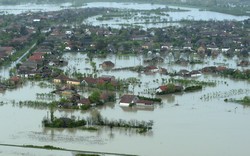Here comes the rain again – Improved statistical models of floods
When water resource managers conduct flood frequency analysis, one of the greatest challenges they face is modelling two or more dependent variables. The project IMPALA (Improved multivariate frequency analysis of flood extremes by copulas in a non-stationary environment) offered a multidisciplinary solution to this problem. The answer comprises copula-based multivariate frequency modelling of flood extremes, which includes information on historical and regional ungauged extremes. Copulas are statistical tools used to describe the dependence between two random variables and are suitable for modelling the frequency of multivariate flood extremes. The IMPALA initiative set out to improve the multivariate frequency modelling of flood variates by increasing the number of observations at the extremes of the marginal distribution of flood data. Extraordinary flood data was included in a univariate flood frequency analysis through Bayesian Markov chain Monte Carlo techniques. The project made use of existing Europe-wide databases of streamflow records and catchment descriptors as well as data from the relevant Austrian and Slovakian authorities. Generally, studies dealing with fitting univariate or multivariate frequency models to observed data do not go beyond the statistics; the hydrological and/or meteorological drivers of flood processes are usually not explored. Therefore, the IMPALA project was mostly governed by the philosophy that it is inevitable to differentiate between flood driving mechanisms. Within the IMPALA project, a novel methodology was developed to identify storm events with convective character on the basis of high resolution climatological data and lightning activity. The methodology proved to be useful in the typology of flood processes since convective storms are precursors of flash floods. In a related study, the variability in the Clausius-Clapeyron rates of increase in precipitation intensity with air temperature was examined. The outcomes have serious implications on hydrological risk: as a consequence of the climate change, the mean air temperature is expected to rise, which implies higher Clausius-Clapeyron scaling rates, and this might be manifested in more severe rainstorms, and consequently, flash floods. Researchers further examined whether floods have changed in the past and explored the processes in the atmosphere, the catchments and the river systems in Europe that drive such changes. Moreover, methods were reviewed for assessing whether floods may increase in the future and suggestions were made for integrated food management to deal with the risk of future flooding. The dependence between flood peaks and flood volumes in Austria was analysed for different flood processes (synoptic, flash and snowmelt floods). It was found that uncertainty in statistical models can be reduced through deeper hydrological analysis of the factors influencing flood peaks and volumes. The reliability of the frequency estimation can also be enhanced by taking into consideration the model's suitability and the flood generation mechanisms in the target region. IMPALA outcomes will help to answer many theoretical and practical questions regarding flood risk and the hydrological cycle. They therefore support the work of the scientific community and will benefit professional end users, flood mitigation policymakers, non-governmental organisations, and national, regional and local authorities.
Keywords
Flood, multivariate, frequency analysis, flood extremes, flood peak, flood volume, copulas, bivariate distribution, Markov chain Monte Carlo, flood driving mechanisms, processes



